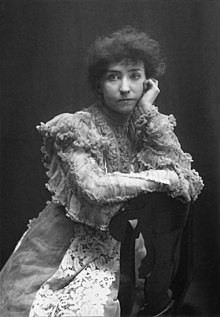Mrs. Fiske
| Mrs. Fiske | |
|---|---|

"Mrs. Fiske: Love Finds the Way."
Photograph by Zaida Ben-Yusuf (1896) |
|
| Born |
Marie Augusta Davey December 19, 1865 New Orleans, Louisiana |
| Died | February 15, 1932 (aged 66) Hollis, Long Island, New York |
| Other names | Minnie Maddern Fiske |
| Occupation | Actress, playwright |
| Spouse(s) | LeGrand White (m. 1882 - June 25, 1888) Harrison Grey Fiske (m. March 19, 1890 - 1932; her death) |
Minnie Maddern Fiske (December 19, 1865 – February 15, 1932), born as Marie Augusta Davey with some sources quoting December 19, 1864, as her date of birth, but often billed simply as Mrs. Fiske, was one of the leading American actresses of the late nineteenth and early twentieth century. She also spearheaded the fight against the Theatrical Syndicate for the sake of artistic freedom. She was widely considered the most important actress on the American stage in the first quarter of the 20th century. Her performances in several Henrik Ibsen plays widely introduced American audiences to the Norwegian playwright.
Born in New Orleans, Louisiana, she was the daughter of stage manager Thomas Davey and actress Lizzie Maddern.
She performed her first professional show at the age of three as the Duke of York in Richard III. She debuted in New York as a four-year-old in the play A Sheep in Wolf's Clothing. She toured extensively as a child, and was educated in many convent schools. She was a child prodigy, touring and performing in numerous productions. According to the New York Times article "Ibsen or Shakespeare?" (March 18, 1928), Harrison Grey Fiske was 12 years old when he first set eyes on the future Mrs. Fiske—she was but eight, performing in a Shakespearean role. Her pay was in lollipops.
By the time she was 16, she was a leading lady, and was cast in the leading role of Chip in the play Fogg's Ferry. She was recognized for her unique beauty and singing voice. She married LeGrand White, a theater musician in Fogg's Ferry, but they divorced shortly thereafter.
Two years later, she married Harrison Grey Fiske in March 1890, and took three years off from the stage. Leaving a life of domesticity, she returned to the theatre in 1893 as a playwright and director, having written one-act plays such as A Light for St. Agnes, The Rose, and The Eyes of the Heart. She wrote several plays and collaborated with her husband in writing Fontenelle. Mr. Fiske directed virtually all of his wife's plays after their marriage.
After her husband's unsuccessful production of Hester Crewe, Minnie Maddern debuted as Nora in A Doll's House by Henrick Ibsen, at the Empire Theatre in New York, launching Ibsen's career because of her outstanding performance. She is perhaps most famous for starring as Becky Sharp in the original 1899 production of Langdon Mitchell's Becky Sharp, a play based on William Makepeace Thackeray's Vanity Fair. Among her many triumphs on the Broadway stage were: Becky Sharp (1899, revivals 1904, 1911), Tess of the d'Urbervilles (1897, revival 1902), A Doll's House (1902), Hedda Gabler (1903, revival 1904), Leah Kleschna (1904–05), Salvation Nell (1908–09), The High Road (1912–13), Madame Sand (1917–18), a play about George Sand; Mis' Nelly of N'Orleans (1919), Helena's Boys (1924), Ghosts (1927), Ladies of the Jury (1929–30), as well as her self-written plays The Rose (1905), The Eyes of the Heart (1905), A Light from St. Agnes (1906). Mrs. Fiske starred in everything from farce to tragedy and even appeared in a comedy with puppets Wake Up, Jonathan! (1921). Her final appearance on Broadway was in 1930 in an acclaimed production of The Rivals cast as Mrs. Malaprop.
...
Wikipedia
